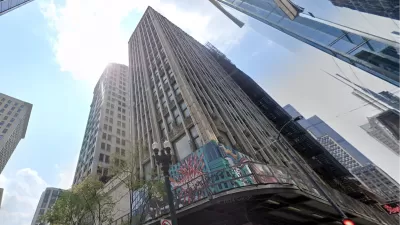Developers in cities like Oakland, California are turning to vintage architectural elements to inform building renovations, but this repackaging is far from traditional preservation work.

Writing in the San Francisco Chronicle, John King describes an architectural trend known as “facadism,” which King describes as “using scraps of sculptural history to maintain stage sets on an urban scale.”
King highlights three examples from Oakland’s old ‘auto row,’ where developers are using the city’s past and existing architectural elements to inform the aesthetics of newly renovated buildings and “retain the pre-existing character while encouraging growth at a scale more dense than before.” King describes three developments on Broadway that “offer a crash course in both the strengths and limitations of such structural nostalgia.”
These include a former car dealership built in 1917, now 127 apartment units; a one-time garage and car showroom from 1916 converted to 107 apartments, which King prefers over the “boilerplate modernism” of the first example; and a block-long hotel and apartment combination also built out of a former auto showroom.
King acknowledges that “In a sense, all types of facadism involve fakery, with relics of the past being repackaged.” However, “The flip side is, this structural recycling genuinely can help urban districts evolve from old to new. The remnants provide links to the past even as the scale and uses are in transition. What’s also preserved, often, is a sense of tactile richness that couldn’t be achieved with today’s budget.”
FULL STORY: New housing in Oakland comes wrapped in historic garb. There’s a reason for that

Planetizen Federal Action Tracker
A weekly monitor of how Trump’s orders and actions are impacting planners and planning in America.

Maui's Vacation Rental Debate Turns Ugly
Verbal attacks, misinformation campaigns and fistfights plague a high-stakes debate to convert thousands of vacation rentals into long-term housing.

Restaurant Patios Were a Pandemic Win — Why Were They so Hard to Keep?
Social distancing requirements and changes in travel patterns prompted cities to pilot new uses for street and sidewalk space. Then it got complicated.

In California Battle of Housing vs. Environment, Housing Just Won
A new state law significantly limits the power of CEQA, an environmental review law that served as a powerful tool for blocking new development.

Boulder Eliminates Parking Minimums Citywide
Officials estimate the cost of building a single underground parking space at up to $100,000.

Orange County, Florida Adopts Largest US “Sprawl Repair” Code
The ‘Orange Code’ seeks to rectify decades of sprawl-inducing, car-oriented development.
Urban Design for Planners 1: Software Tools
This six-course series explores essential urban design concepts using open source software and equips planners with the tools they need to participate fully in the urban design process.
Planning for Universal Design
Learn the tools for implementing Universal Design in planning regulations.
Heyer Gruel & Associates PA
JM Goldson LLC
Custer County Colorado
City of Camden Redevelopment Agency
City of Astoria
Transportation Research & Education Center (TREC) at Portland State University
Jefferson Parish Government
Camden Redevelopment Agency
City of Claremont





























